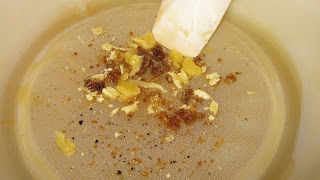For those of you that weren't around last year, I'll take you thru the steps. The rest of you can just glaze on thru...
First, you remove the frames from the hive. Brush off all bees if you are bringing them inside. :o)
Check out Pig Pen's fancy new stainless steel Decapping Tank...pretty cool, huh?
Another one of his designs. Last year we put screening over a rubbermaid container and shimmied around it. Not this year.
Next is to "Decap" the comb. The bees 'cap' off the honey combs with wax once they have completed their work. Alot of folks will use a heat knife. We found a serrated knife and a warm pan of water works just fine. The goal being not to heat the honey but rather, keep it "raw".
Keith spank shined the decapping tank all pretty like and then he got sticky! ;o) Hey, never a relaxing moment around here!!
Once you decap, the wax falls to the bottom along with any honey drippings as well. Not to worry, it doesn't go to waste!
Then you load up the fancy new extractor! Some of you may recall from last year that Pig Pen fabricated his own design on a Honey Extractor. This year, he decided to rebuild it to hold 12 frames as opposed to 4. And instead of the Dewalt to spin it, he mechanized it. Yup, a motor!
Well it worked pretty good until they realized we need a bigger motor! 12 frames are pretty darn heavy! Hopefully by this Fall when the BIG harvest comes in...
The honey gets strained thru two screens to remove any fallen bee soldiers, wax, or other particles. We then bottle it up!
And oh yes, stickers on each and every bottle!That's it! No heating, mixing, or funny business!
Since there is still loads of wax and honey on the wax in the decapping tank, I slowly simmered it on the stove top. This process melts the wax entirely and it looks like a big pot of golden goodness. Then it cools.
As the wax re-solidifies, it floats to the top along with any other 'junk' and forms a cap on the pan.
Let me tell ya, you could use a pry bar to get that out!
Once you remove the wax cap, you run this honey thru the screens also. The wax will be saved for another day and another project.
The screens sit on top of the bucket. Here is what's left after it is done!
This is what we call "Bakers Honey". There ended up being approximately 20 lbs.
Because it has been heated, I will use it for all my baking needs. Don't get me wrong this isn't a bad thing! It's phenomenal tasting with a deep amber color. But I wont sell this as part of our "Raw" honey.
Bakers Honey on Left. Raw Honey on Right.
As the raw honey settles, the tiny air bubbles from screening and bottling clear to a nice light golden color. It is outstanding! It has a wonderful floral honey scent.
We also did what I like to refer to as "Old Timer's Honey".
Old Timer's will tell tales of taking a spoonful straight from the comb, wax and all! Enjoy the honey and chew the wax like gum! Note: a little dab'll do ya! Right, Tricia??
These are actually called Ross Rounds and they are placed in the hive boxes in round frames and then packaged as is!
Not including the 32 Ross Rounds, we harvested a whopping...
240 pounds
of honey so far!!
Last years total harvest was 157 lbs.
According to my calculations, our honey sales might provide us enough grocery funds to compensate for a lousy gardening/canning year! Bright side to everything, right?































































